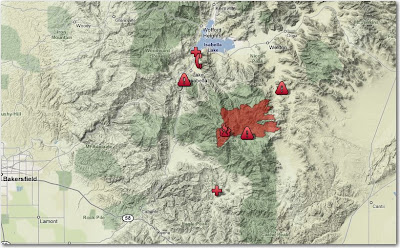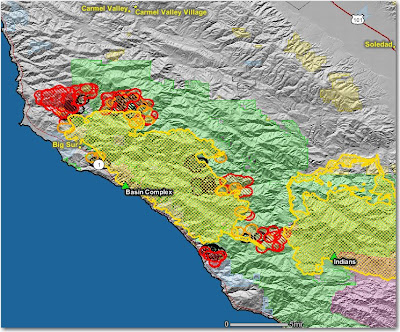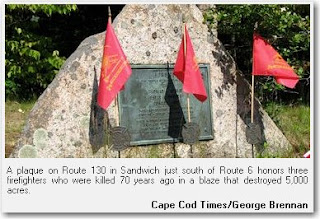An article in the Monterey County Herald explores the current state of preparedness of federal firefighters. Here are some excerpts:
Preparedness under fire: Federal firefighting system understaffed, report shows
Federal system understaffed, report shows
By JULIA REYNOLDS
Herald Staff Writer
Article Last Updated: 07/07/2008 01:33:12 AM PDT
The federal firefighting system is “imploding” in California, due to poor spending decisions and high job vacancy rates, as the region struggles to keep pace with what looks to be a historic fire season, a firefighters’ advocacy group charges.
As a result, the firefighters say, small fires have exploded into extended, multimillion-dollar conflagrations because the U.S. Forest Service has been unable to contain them during the early “initial attack” stage.
“The federal fire system is imploding in California. They are crossing their fingers and just hoping they get through the season without a disaster,” said Casey Judd, who represents government firefighters from five agencies through the Federal Wildland Fire Service Association.
As the “sheer number” of California wildfires pushed the nation to its worst measurable level of wildland-fire preparedness last week — Level 5 — a national multiagency coordinating group announced in a memo Monday that firefighter staffing levels in Northern California “cannot be maintained.”
In past years, the nation’s average fire-preparedness level for June and July has hovered around a moderate 2 or 3. A Level 5 means that national firefighting resources are stretched critically thin across several regions.
By last Wednesday, 84 wildfires in California were being allowed to burn “unstaffed,” according to a report issued by the National Park Service.
“Many of the existing fires in Northern California have the potential to burn through much of the summer and into the fall until rainfall increases,” said the report, which called the current fire season “unprecedented” and described the firefighter shortage as “acute.”
Of all the agencies battling California wildland fires — including the region’s two largest, the Indians and Basin fires in Monterey County’s Los Padres National Forest — it is U.S. Forest Service crews that suffer the highest vacancy rates, entering this year’s season with an estimated shortage of 500 firefighters, Judd said. Fully staffed, the region has authorized a force of 4,432 firefighters for the season.
Last year, the Forest Service’s Southern California region lost 47 percent of its newly hired firefighting work force, according to a Forest Service report.
[…]
Many engines unmanned
After facing pressure from California Sen. Dianne Feinstein and other lawmakers last spring, the Forest Service promised it would immediately fill its vacancies and launched a “Fire Hire” campaign to attract firefighters in Sacramento that concluded two weeks ago.
“I believe the agency should have been able to muster a stronger force,” Feinstein said. “All signs indicate that things will only get worse.”
Feinstein said that despite promises of full staffing from Rey, only 186 of the agency’s 276 engines were manned at the start of the 2008 fire season.
Ron Thatcher, president of the union that represents 20,000 Forest Service employees, has estimated that attrition has left the service at 70 percent to 80 percent of its authorized staffing levels, and that up to 39 percent of fire crew leader positions were vacant as the 2008 fire season kicked off.
Unequal pay
Part of the service’s retention problem lies in the fact that when called to battle a wildfire for two or more weeks, federal firefighters are only paid for up to 14 hours’ work per day, while their state counterparts are paid “portal to portal” — that is, 24 hours’ pay for all the days they are on scene, including rest days.
Federal firefighters are “away from home, away from family. And they’re working alongside others who are going to get compensated for all their time, while they’re not,” Judd said. “It’s just nutty.”
[…]
Clueless about program
Another issue that firefighters say may come back to bite the region is a brand-new budgetary program — called “accountable cost management”— that was just introduced throughout the Forest Service. Judd said it should have been initiated well before the 2008 fire season started.
“National fire commanders could have been briefed on this during the winter and created a budget. The program was thrown on fire chiefs in the summer,” Judd said.
“The Indians Fire commander had no clue about this program, and they’re looking at (cutting) the least expensive resources. The bean counters are looking at these folks and basically timing them as to how long they spend on dinner. Accountable cost management is you’re looking at minutiae and ignoring the real costs,” Judd said.
“We think obviously there should be a mechanism for cost containment, but it works better for static programs rather than something as dynamic as fire,” he said.
 o miles on the west side of King Solomon Ridge to King Solomon peak, and ate up significant acreage on the north side, while blowing across firelines on the west side in the Red Mountain area.
o miles on the west side of King Solomon Ridge to King Solomon peak, and ate up significant acreage on the north side, while blowing across firelines on the west side in the Red Mountain area.




